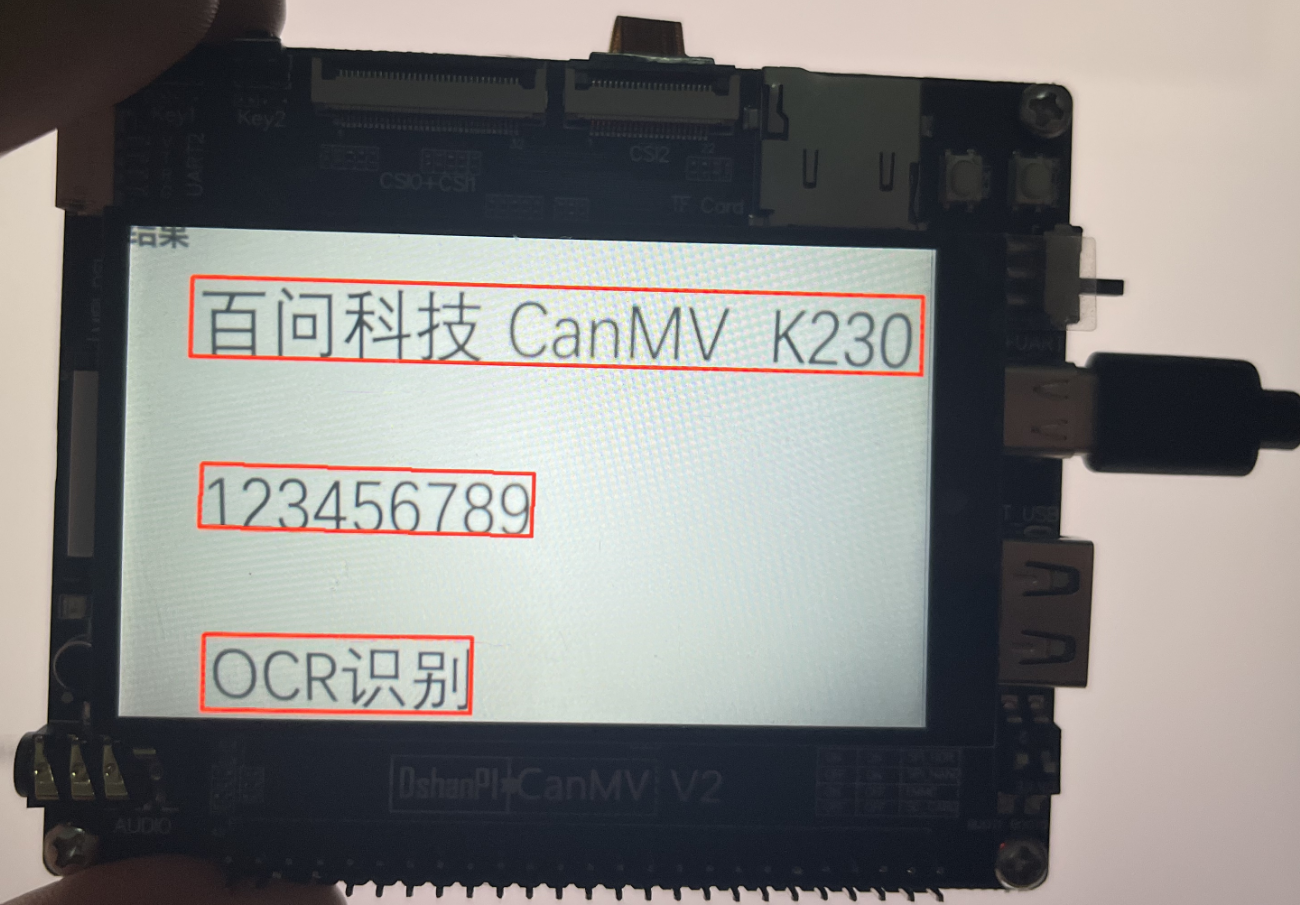OCR文字检测
1.实验目的
实现摄像头画面的字符检测。
2.核心流程
根据显示模式(hdmi或lcd)设置显示分辨率。
设置OCR模型路径、阈值和图像尺寸。
初始化PipeLine,并开始创建图像采集和显示管道。
实例化OCRDetectionApp对象,配置预处理方法。
进入循环,不断获取图像帧进行推理、后处理和绘制结果。
在循环内部,调用pl.get_frame()获取图像帧,使用ocr_det.run()执行推理,最后通过ocr_det.draw_result()绘制检测结果到显示设备。
3.示例代码
'''
本程序遵循GPL V3协议, 请遵循协议
实验平台: DshanPI CanMV
开发板文档站点 : https://eai.100ask.net/
百问网学习平台 : https://www.100ask.net
百问网官方B站 : https://space.bilibili.com/275908810
百问网官方淘宝 : https://100ask.taobao.com
'''
from libs.PipeLine import PipeLine, ScopedTiming
from libs.AIBase import AIBase
from libs.AI2D import Ai2d
import os
import ujson
from media.media import *
from time import *
import nncase_runtime as nn
import ulab.numpy as np
import time
import utime
import image
import random
import gc
import sys
import aicube
# 自定义OCR检测类
class OCRDetectionApp(AIBase):
def __init__(self,kmodel_path,model_input_size,mask_threshold=0.5,box_threshold=0.2,rgb888p_size=[224,224],display_size=[1920,1080],debug_mode=0):
super().__init__(kmodel_path,model_input_size,rgb888p_size,debug_mode)
self.kmodel_path=kmodel_path
# 模型输入分辨率
self.model_input_size=model_input_size
# 分类阈值
self.mask_threshold=mask_threshold
self.box_threshold=box_threshold
# sensor给到AI的图像分辨率
self.rgb888p_size=[ALIGN_UP(rgb888p_size[0],16),rgb888p_size[1]]
# 显示分辨率
self.display_size=[ALIGN_UP(display_size[0],16),display_size[1]]
self.debug_mode=debug_mode
# Ai2d实例,用于实现模型预处理
self.ai2d=Ai2d(debug_mode)
# 设置Ai2d的输入输出格式和类型
self.ai2d.set_ai2d_dtype(nn.ai2d_format.NCHW_FMT,nn.ai2d_format.NCHW_FMT,np.uint8, np.uint8)
# 配置预处理操作,这里使用了pad和resize,Ai2d支持crop/shift/pad/resize/affine,具体代码请打开/sdcard/app/libs/AI2D.py查看
def config_preprocess(self,input_image_size=None):
with ScopedTiming("set preprocess config",self.debug_mode > 0):
# 初始化ai2d预处理配置,默认为sensor给到AI的尺寸,您可以通过设置input_image_size自行修改输入尺寸
ai2d_input_size=input_image_size if input_image_size else self.rgb888p_size
top,bottom,left,right=self.get_padding_param()
self.ai2d.pad([0,0,0,0,top,bottom,left,right], 0, [0,0,0])
self.ai2d.resize(nn.interp_method.tf_bilinear, nn.interp_mode.half_pixel)
self.ai2d.build([1,3,ai2d_input_size[1],ai2d_input_size[0]],[1,3,self.model_input_size[1],self.model_input_size[0]])
# 自定义当前任务的后处理
def postprocess(self,results):
with ScopedTiming("postprocess",self.debug_mode > 0):
# chw2hwc
hwc_array=self.chw2hwc(self.cur_img)
# 这里使用了aicube封装的接口seg_post_process做后处理,返回一个和display_size相同分辨率的mask图
# det_boxes结构为[[crop_array_nhwc,[p1_x,p1_y,p2_x,p2_y,p3_x,p3_y,p4_x,p4_y]],...]
det_boxes = aicube.ocr_post_process(results[0][:,:,:,0].reshape(-1), hwc_array.reshape(-1),self.model_input_size,self.rgb888p_size, self.mask_threshold, self.box_threshold)
all_boxes_pos=[]
for det_box in det_boxes:
all_boxes_pos.append(det_box[1])
return all_boxes_pos
# 绘制结果
def draw_result(self,pl,all_boxes_pos):
with ScopedTiming("display_draw",self.debug_mode >0):
pl.osd_img.clear()
# 一次绘制四条边,得到文本检测的四边形
for i in range(len(all_boxes_pos)):
for j in range(4):
x1=all_boxes_pos[i][2*j]*self.display_size[0]//self.rgb888p_size[0]
y1=all_boxes_pos[i][2*j+1]*self.display_size[1]//self.rgb888p_size[1]
x2=all_boxes_pos[i][(2*j+2)%8]*self.display_size[0]//self.rgb888p_size[0]
y2=all_boxes_pos[i][(2*j+3)%8]*self.display_size[1]//self.rgb888p_size[1]
pl.osd_img.draw_line(int(x1),int(y1),int(x2),int(y2),color=(255,255,0,0),thickness=4)
# 计算padding参数
def get_padding_param(self):
# 右padding或下padding
dst_w = self.model_input_size[0]
dst_h = self.model_input_size[1]
input_width = self.rgb888p_size[0]
input_high = self.rgb888p_size[1]
ratio_w = dst_w / input_width
ratio_h = dst_h / input_high
if ratio_w < ratio_h:
ratio = ratio_w
else:
ratio = ratio_h
new_w = (int)(ratio * input_width)
new_h = (int)(ratio * input_high)
dw = (dst_w - new_w) / 2
dh = (dst_h - new_h) / 2
top = (int)(round(0))
bottom = (int)(round(dh * 2 + 0.1))
left = (int)(round(0))
right = (int)(round(dw * 2 - 0.1))
return top, bottom, left, right
# chw2hwc
def chw2hwc(self,features):
ori_shape = (features.shape[0], features.shape[1], features.shape[2])
c_hw_ = features.reshape((ori_shape[0], ori_shape[1] * ori_shape[2]))
hw_c_ = c_hw_.transpose()
new_array = hw_c_.copy()
hwc_array = new_array.reshape((ori_shape[1], ori_shape[2], ori_shape[0]))
del c_hw_
del hw_c_
del new_array
return hwc_array
if __name__=="__main__":
# 显示模式,默认"hdmi",可以选择"hdmi"和"lcd",k230d受限内存不支持
display_mode="lcd"
if display_mode=="hdmi":
display_size=[1920,1080]
else:
display_size=[800,480]
# 模型路径
kmodel_path="/sdcard/examples/kmodel/ocr_det_int16.kmodel"
# kmodel其它参数设置
mask_threshold = 0.25
box_threshold = 0.3
rgb888p_size=[640,360]
# 初始化PipeLine
pl=PipeLine(rgb888p_size=rgb888p_size,display_size=display_size,display_mode=display_mode)
pl.create()
# 初始化自定义OCR检测实例
ocr_det=OCRDetectionApp(kmodel_path,model_input_size=[640,640],mask_threshold=mask_threshold,box_threshold=box_threshold,rgb888p_size=rgb888p_size,display_size=display_size,debug_mode=0)
ocr_det.config_preprocess()
try:
while True:
os.exitpoint()
with ScopedTiming("total",1):
# 获取当前帧数据
img=pl.get_frame()
# 推理当前帧
res=ocr_det.run(img)
# 绘制结果到PipeLine的osd图像
ocr_det.draw_result(pl,res)
# 显示当前的绘制结果
pl.show_image()
gc.collect()
except Exception as e:
sys.print_exception(e)
finally:
ocr_det.deinit()
pl.destroy()
4.实验结果

运行代码后,可以在显示屏看到检测结果:
